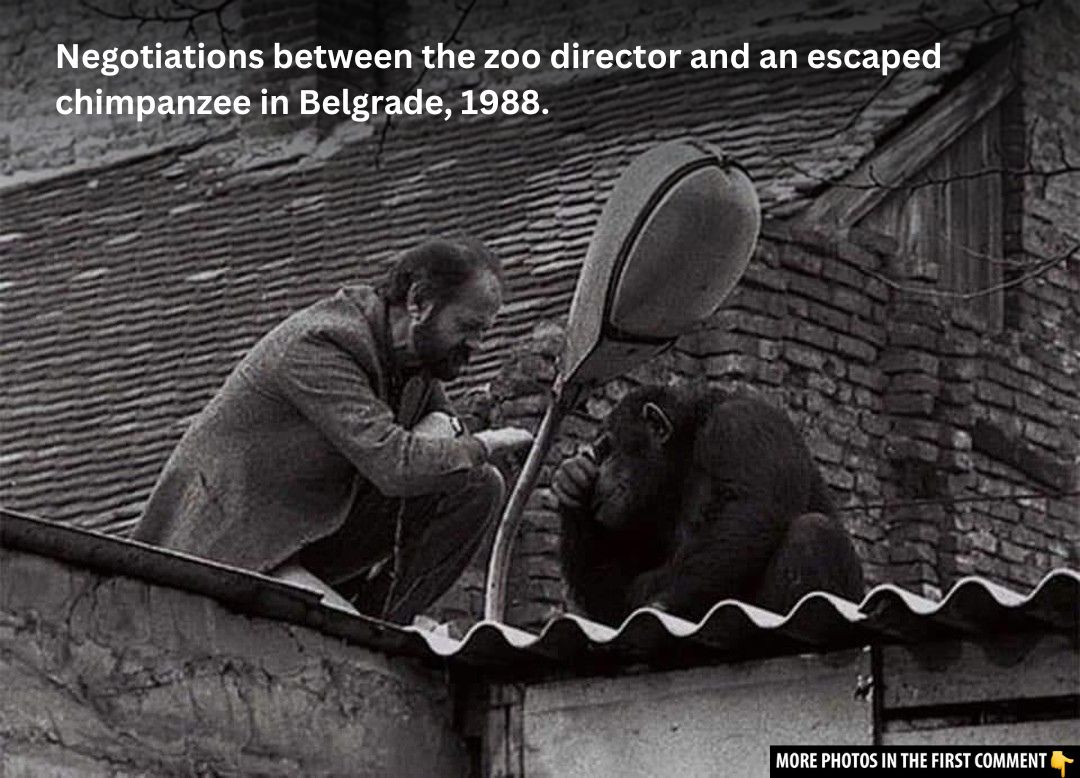In 1988, a chimpanzee named Sami became an unlikely hero for the people of Belgrade, Yugoslavia. His remarkable escapes from the Belgrade Zoo captured the city’s imagination, transcending the realm of animal stories and becoming a symbol of rebellion, freedom, and solidarity. Over the course of two dramatic escapes, Sami defied the constraints placed upon him, not just by the zoo, but by society at large. His story captivated the public, and his brief moments of freedom sparked a collective desire for a world different from the one they knew. This is the tale of Sami, a chimpanzee whose flight from captivity echoed the unspoken frustrations of an entire population.
Sami’s Early Life: From Osijek Zoo to Belgrade
Sami was born in 1979 at the Osijek Zoo and Aquarium in Croatia, and from the start, he was a striking specimen—well-built with a thick, glossy coat. His journey to the Belgrade Zoo in January 1988 marked a significant turning point in his life. The transition from a spacious environment in Osijek to a cramped, poorly maintained enclosure in Belgrade was not kind to Sami. The new setting, with its reinforced grid and inadequate space, only served to intensify his feelings of confinement. Shortly after arriving, Sami began exhibiting signs of distress, including aggression and depression. He was alone in the enclosure with no companion, which likely fueled his desire for escape.
The conditions were harsh, and Sami’s behavior grew more erratic by the day. But it was clear to the zoo staff that something needed to be done—Sami was not just an animal in captivity; he was a creature who had developed an awareness of his situation. The zoo director, Vuk Bojović, was faced with the challenge of addressing Sami’s growing frustration, but little did anyone know that the solution would not come from a traditional approach.
Video
Watch this video to see Sami the chimp escape from the zoo and the dramatic events that followed!
The First Escape: A Walk Around Central Belgrade
Sami’s frustration reached its peak on the evening of February 21, 1988, when he made his first daring escape. Local news suggested that Sami, feeling isolated and likely in search of a mate, managed to break free from his cage and wandered through the streets of Belgrade. His route included notable landmarks like the Balkan Cinema and Kalemegdan Park. The chimpanzee’s leisurely stroll was short-lived, as the police managed to corner him at Students Square. Despite the brief standoff, Sami was soon coaxed back to the zoo, but this was just the beginning of his story.
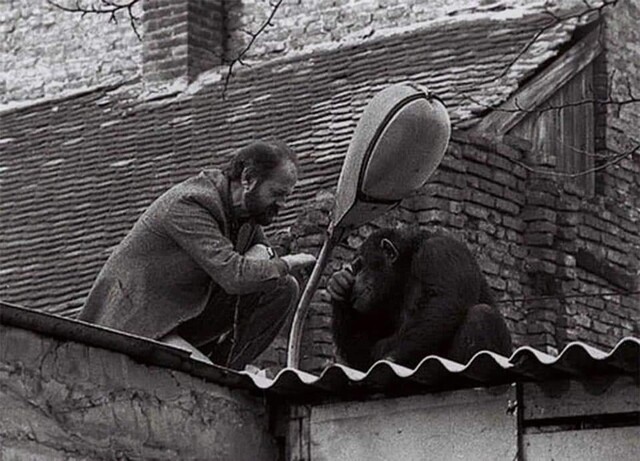
The Second Escape: A City-Wide Chase
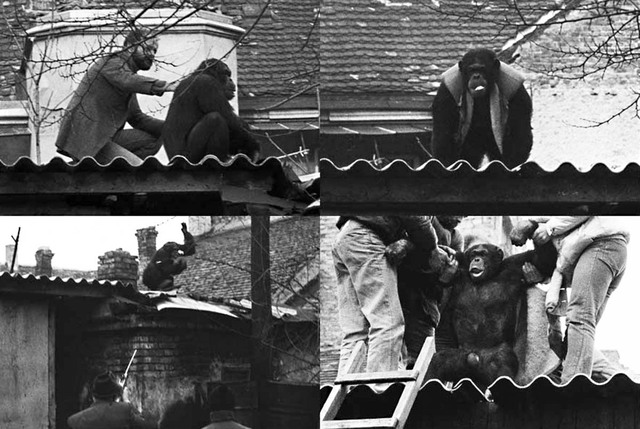
Just days after his return, Sami made a second, more defiant escape. This time, he refused to go back to his cage. The zoo staff, unable to reason with him, turned to Vuk Bojović, the zoo director. Sami had formed a bond with Bojović, and it was he who was trusted to bring Sami back. In a calm and personal moment, Bojović gently took Sami by the arm and said, “Come on, Sami, let’s go home,” and successfully led him back to the zoo in his personal car.
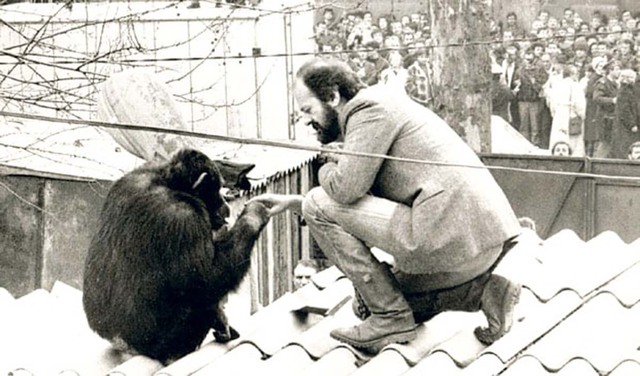
However, Sami’s determination didn’t end there. Just days later, he escaped once again, this time breaking out with ease and heading toward the Beko Factory. Despite the efforts of factory workers who tried to capture him with a large net, Sami managed to evade them and continued his urban adventure. He was eventually chased to a courtyard at 33 Tsar Dušan Street, where he climbed a cherry tree and perched on top of a garage, causing a spectacle in the city.
The Public’s Support: A Moment of Solidarity
Sami’s second escape quickly transcended an animal’s desire for freedom—it became a citywide movement. As Sami climbed higher, a crowd of over four thousand Belgraders gathered to cheer him on. The city watched with bated breath as Sami, the chimpanzee, became an unlikely hero. People held placards reading “Sami, we’re with you!” and “Don’t give yourself up, Sami!” The emotional connection between Sami and the people of Belgrade was palpable. For them, Sami’s escape represented more than a chimpanzee’s flight from captivity—it symbolized a collective desire for freedom and rebellion against the confines of society.

Legacy: Sami’s Place in Belgrade’s History
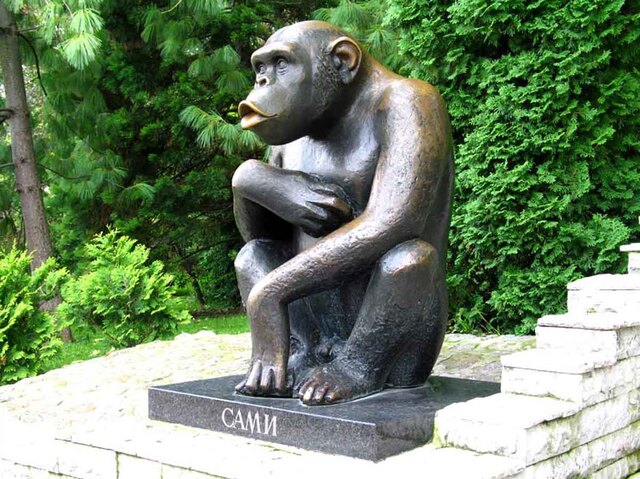
Sami passed away unexpectedly on September 11, 1992, but his story remains deeply etched in the memories of Belgrade’s citizens. In his honor, a bronze statue was erected at the zoo, a testament to his status as one of Belgrade’s most beloved figures. The statue stands not just as a reminder of an animal’s escape but as a symbol of the city’s collective longing for freedom.
Sami’s death prompted an outpouring of eulogies, with many newspapers referring to him as a “dissident”—a symbol of resistance against the constraints of society. His escape, much like the frustrations felt by many in Yugoslavia under the shadow of Soviet influence, served as a temporary rupture in the social fabric. In the eyes of the people, Sami was a hero who had dared to break free from the systems that sought to control him.
Sami as a Dissident: A Symbol of Rebellion
Sami’s escape was not just an animal story; it became an allegory for the social and political tensions of the time. Yugoslavia, under the grip of communism and the legacy of Josip Tito, was a nation still haunted by political repression. For a brief moment, Sami’s refusal to comply with authority mirrored the desires for change that simmered just below the surface in Belgrade. In a city where dissent was often met with harsh consequences, Sami’s actions resonated with those who longed for freedom.
Had Sami been a human, he might have faced arrest for his defiance. But as an animal, he became a figure of resistance that could not be punished, allowing the people of Belgrade to cheer for him without fear of reprisal.
Video
Watch this video to explore Belgrade Zoo, also known as Zoološki Vrt Beograd, and its fascinating animal exhibits!
Conclusion: Sami’s Enduring Legacy and Symbolism
Sami the chimpanzee’s story is more than just a tale of an animal’s escape from captivity—it is a powerful symbol of rebellion, freedom, and the human desire to break free from societal constraints. For a fleeting moment, Sami united the people of Belgrade in their collective yearning for change, and his legacy continues to resonate in the city today. His escape sparked a brief but powerful rupture in the social fabric, allowing the people to imagine a world where the impossible was possible. Sami may no longer be with us, but his spirit lives on in the hearts of those who continue to remember the chimpanzee who, for a moment, became a hero.
